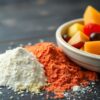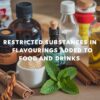As a product developer, you’ve likely encountered that moment of dread: a customer or panel complaint about an “odd taste” in your carefully crafted beverage. These unwanted off-notes can be the bane of any beverage manufacturer’s existence. This article will look at some of the causes and most common off-notes, and equip you with the knowledge to combat these pesky flavour intruders.
 What Are Off-Notes?
What Are Off-Notes?
Off-notes are those undesirable flavours or aromas that deviate from a product’s intended taste profile. They can range from subtle nuances to overpowering defects that render a product unpalatable. They can occur at the point of development, or only rear their ugly head when the product is on the shelves. As you know in the beverage industry, maintaining flavour consistency is crucial; making the management of off-notes a top priority.
The Rogues’ Gallery: Common Off-Notes in Beverages
Let’s look into some of the most frequent offenders, are any of these familiar?
- Metallic: A tinny or blood-like taste often associated with iron contamination.
- Cardboard/Paper: A flat, stale flavour reminiscent of wet cardboard.
- Skunky: A sulfurous aroma, common in light-struck beer.
- Rancid: A fatty, oxidized flavour often found in products containing oils.
- Musty/Moldy: An earthy, basement-like taste indicative of mold contamination.
- Soapy: A flavour reminiscent of dish soap, often due to lipid oxidation.
- Burnt: An acrid, overcooked flavour often resulting from excessive heat treatment.
The Usual Suspects: Causes of Off-Notes
Understanding the root causes of off-notes is crucial for prevention. Here are the primary culprits:
1. Functional Ingredients
- Proteins: A big cause of off-notes from earthy, to vegetal to animalic aroma depending on the source
- Vitamin mixes: A great selling point but a major cause of bitterness in your beverage.
- Greens: All the rage but these with give unwanted wet grass or at worst sileage-like flavour.
2. Chemical Reactions
- Oxidation: The nemesis of flavour stability, leading to cardboard, rancid, or metallic notes.
- Ingredient interactions: Unstable flavours and other ingredients can react and degrade over-time leading to unpleasant aromas.
- Maillard Reactions: Less common in beverages but incorrect pasteurisation can lead to unwanted cooked notes in milk drinks and juices.
3. Microbial Contamination
- Bacteria: Can produce a range of off-flavours, from sour to putrid.
- Yeast: May cause fermented or alcoholic notes in non-alcoholic beverages.
- Mold: Responsible for musty or earthy off-notes.
4. Environmental Factors
- Light Exposure: Can trigger photochemical reactions, leading to skunky flavours in certain beverages.
- Incorrect Storage Temperature: Accelerates chemical reactions and microbial growth.
- Packaging Interactions: Migration of compounds from unsuitable packaging materials can impart plastic or metallic notes.
Fighting Back: Prevention and Mitigation Strategies
Now that we’ve identified the enemy, let’s arm ourselves with strategies to combat off-notes! These cover from the time we’re formulating our beverage concept, right up until our product is on the shelves:
1. Development:
- Ensure the formulation doesn’t release off-notes from the get-go. Raw material suppliers and flavour houses should help overcome any off-notes at this stage, with technical ingredients such as maskers and flavour enhancers being deployed if off-notes are present as a result of the formulation itself.
2. Panelling:
- Panels passed after initial development should be repeated after scale-up production testing and accelerated shelf-life tests to ensure that no off-notes develop after this, and the product remains consistent(-ly good!) in accordance with the original panel results.
3. Quality Control:
- Implement rigorous testing protocols for ingredients, ensuring that Certificates of Analysis are in conformance from batch-to-batch, but even better have a protocol for both organoleptic and chemical testing of raw materials for every batch. Use suppliers with a good track record for consistency.
4. Process Optimization:
- Fine-tune manufacturing processes in the scale-up trials to minimize thermal abuse and oxidation, and if applicable stay consistent with pasteurisation and all other manufacturing parameters such as mixing times.
5. Packaging Innovation*:
- (*Although this should be considered from before launch it is something that may only be raised as an issue after launch). Utilize light-protective and oxygen-barrier packaging materials when possible. Nitrogen dosing for RTDs if you have the facility further helps prevents oxidisation.
6. Antioxidant/ Preservatives*:
- (*Similarly this should be noted at development stage but the issue may only present itself post-launch). Incorporate natural or synthetic antioxidants and preservatives to slow oxidation processes and keep the flavour profile consistent. This may also be required for colour stability throughout shelf life.
7. Storage and Distribution:
- Maintain proper temperature controls throughout the supply chain including up to and including at the point of sale.
The Bottom Line
Managing off-notes is an ongoing battle in beverage product development and production, which is getting more complicated with the increasing demand for functional claims introducing ingredients which introduce unpleasant tastes.
If you’re part of a larger beverage company then you should have the resources to keep off-notes at bay, but if not there’s a plethora of beverage developers or contract manufacturers that can be consulted to offer advice too. Let us know if you need any introductions.
By understanding the off-notes you may encounter and their causes, and implementing robust prevention strategies, it is possible to ensure your products deliver the taste experience you intended, and delight your customers every time.
Ready to elevate your beverage quality? Contact our flavour experts for personalized strategies to combat off-notes in your products.


 What Are Off-Notes?
What Are Off-Notes?




